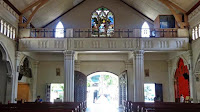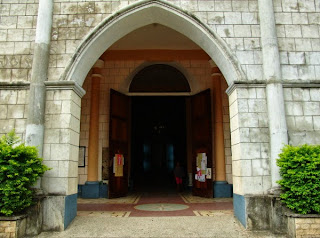Buddhist Temple

BUDDHIST TEMPLE -A temple at V. Gullas Street in the old dowtown of Cebu City dedicated to Guan Yu, a general serving under the warlord Liu Bei during the late Eastern Han ...
Guan Yu was given a posthumous title of Zhuangchou Hou (Marquis of Zhuangchou). His son Guan Xing succeeded him. Guan Xing, styled Anguo, was one who seldom questioned commands, was very well favored by the Lieutenant Chancellor Zhuge Liang. Guan Xing was appointed as Shizhong (Palace Attendant) and Zhongjianjun (Superintendent of the Central Army) when his health failed. A few years later, he passed away. His son Guan Tong succeeded him and had a post of Huben Zhonglang Jiang (General of the Tiger Swiftness) and he died without a son.

BUDDHIST TEMPLE -A temple at V. Gullas Street in the old dowtown of Cebu City dedicated to Guan Yu, a general serving under the warlord Liu Bei during the late Eastern Han ...
Guan Yu was given a posthumous title of Zhuangchou Hou (Marquis of Zhuangchou). His son Guan Xing succeeded him. Guan Xing, styled Anguo, was one who seldom questioned commands, was very well favored by the Lieutenant Chancellor Zhuge Liang. Guan Xing was appointed as Shizhong (Palace Attendant) and Zhongjianjun (Superintendent of the Central Army) when his health failed. A few years later, he passed away. His son Guan Tong succeeded him and had a post of Huben Zhonglang Jiang (General of the Tiger Swiftness) and he died without a son.
Baluarte
Bahay na Bato
The Heritage and Ancestral Houses of Taal, Batangas With the town’s history tracing back to 1572, it was only but natural to see Spanish culture deeply entrenched in the place. Perhaps the most salient are the ancestral houses which line most of the streets in the town proper. Although the assertion that bahay na bato was passed on by the Spaniards is debatable (as they are seen as simply improvements of the bahay kubo), it would be quite naive to deny the huge influence of the Spaniards on the style and architecture of these ancestral houses.
At the heart of downtown San Fernando, Pampanga is the historic poblacion, replete with remnants of the city's rich architectural heritage and history. These architectural legacies, together with the intangible culture of the city, are the focus of the urban renewal program of the City of San Fernando called Preserving Heritage for Progress. In fact, the program was recognized as one of the Top 10 Best Practices of the League of Cities of the Philippines, and a Trailblazing Program of the Galing Pook Awards both in 2004
.
Bahay na Bato - Juban, Sorsogon - The town center of Juban, there are several old houses, known as bahay na bato, still relatively well-preserved and intact although their groundfloors have, long ago, been turned into commercial establishments, such as stores, barber shops and beauty salons, etc. These old houses still have their original tall, sliding windows made of capiz, including carved wooden balustrades just below the window sills. Inside, one can still find original, well-preserved antique furnitures, including other antiquities. Private historical or heritage collections can also be found inside these houses.
Yap-Sandiego
The Yap-Sandiego Ancestral House located in Parian District is one of the oldest, residential houses in the country. This “Balay nga Bato ug Kahoy” (house of stones and wood) was constructed out of coral stones,“balayong” and “tugas” (molave) wood, egg whites served as glue and “tisa” (clay) for the roof. It was a home built by Don Juan Yap (a Chinese merchant) and his wife, Doña Maria Florido, between 1675 and 1700. The couple had three children namely, Maria, Eleuterio and Consolacion Yap. In the 1880s, Don Juan’s eldest daughter Maria married Mariano Avendano Sandiego, who is originally from Obando, Bulacan and at that time, was the cabeza de barangay (District Head) of Parian. At present, the ancestral home was turned over in 2008 to Doña Maria’s great great grandson, Val Mancao Sandiego and his wife Ofelia and was later converted to a museum. Val Sandiego is known in Cebu as a heritage icon, renowned choreographer and art collector. To date, he and his family still find time to spend their weekends there.
Bahay ni Tana Dicang
Balay ni Tana Dicang is at 36 Rizal Street, Talisay City, Negros Occidental. Built c. 1872, it's a huge classical balay-nga-bato or house-of-stone that has maintained its original structure. Its contents, too, are authentic. It stands on a 6,000-square meter property.
The Balay ni Tana Dicang is the ancestral home of Don Efigenio Lizares and Doña Enrica Alunan.After her husband died, Doña Enrica took over raising her big brood, managing the hacienda, and serving as Kapitana, thus her being called Tana Dicang.
Much is learned from the house itself -- history, cultural heritage, architecture, human relationships, love for hearth and home, family.
Historically, the house represents the lifestyle of the sugar barons during the late 19th century.
Casa Comunidad de Tayabas
The Casa Comunidad de Tayabas, It is where the controversial Hermano Pule (Apolinario de la Cruz) was sentenced to death in 1841 after he was found guilty of instigating a mutiny based on his own spiritual convictions. Referred to as “ang símbolo ng Tayabas”, this splendid executive edifice was constructed utilizing community funds from the once prosperous town called La Muy Noble Villa de Tayabas. One could only imagine how Tayabeño life in those days must have been. The town naturally was a showcase of the colonial state, and it has called the attention of many illustrious Castilas like Don Enrique de Borbón, a descendant of King Philip who once stayed in Tayabas as a regal executive.
Quema House
The Quema House is the ancestral home of the Quema family in the Philippines. Built in the 1820s, it is a historic landmark in the town of Vigan, Ilocos Sur in the Philippines. The town itself was declared a UNESCO World Heritage Site in 1999.
In pre-Hispanic times up to the early 16th century, Vigan was a major commercial center in the region, trading directly with China. This commerce resulted to Chinese migration into the area with subsequent intermarriage between the native inhabitants and the Chinese immigrants. During the Spanish colonial period (1521-1898), Vigan became an important supplier of goods for the Manila-Acapulco galleon trade, which led to the rise of a new merchant class whose members are of mixed Chinese, native and Spanish ancestry - the Filipino mestizos. With their increasing affluence, they built their residential houses (bahay-na-bato) in the eastern district of the town, previously the Kasanglayan or old Chinese quarters. It is here that Chinese trader Don Enrique Quema built his ancestral house in the early 19th century.
Ciudad ti Bigan
The City of Vigan (Ilokano: Ciudad ti Bigan; Tagalog: Lungsod ng Vīgân) is a fourth class city and capital of the province of Ilocos Sur in the Philippines. The city is located on the western coast of the large island of Luzon, facing the South China Sea. According to the 2010 Philippines census, it has a population of 49,747 people.
It is a World Heritage Site in that it is one of the few Hispanic towns left in the Philippines where its structures remained intact, and is well known for its cobblestone streets, and a unique architecture that fuses Philippine and Oriental building designs and construction, with colonial European architecture. Because of this, Vigan City was officially recognized as one of the New7Wonders Cities together with Beirut, Doha, Durban, Havana, Kuala Lumpur, and La Paz.
Calle Crisologo
Calle Crisologo city of Vigan in Ilocos Sur, Philippines makes it to the New 7 Wonder Cities of the World. Its well-preserved boasts of surviving Spanish colonial aura with stately homes, tiled roof mansions with capiz shell windows, cobblestone streets and horse-drawn carriages called “calesa”. Calle Crisologo is also closed to traffic.
Some of these huge houses have ground floor souvenir shops and the second floor is used as dwelling. Antique shops and pottery abound the place much as the aroma of freshly baked empanadas. Walking in the streets of Vigan remind you of the notes from Noli Me Tangere and El Filibusterismo.
Pamintuan Mansion
The Pamintuan Mansion once had Gen. Emilio Aguinaldo as its resident. It was here on 12 June 1899 that the first anniversary of Philippine independence was marked, with Pres. Aguinaldo, Del Pilar and other military heroes in attendance. Yearly, the city stages a re-enactment of that historic celebration.
One of the signature landmarks of the city of Angeles is a residential home, a house of memory and history that stands along Sto. Entierro Street, just 2 blocks away from the ancient Sto. Rosario Church, itself a revered structure with a many storied past. This is the Pamintuan House, built sometime in the 1880s by the patriarch, Don Florentino Torres Pamintuan (1868-1925), a successful haciendero who earned his fabulous fortune from his vast agricultural lands.
In a prime location in the town’s residential district, he constructed one of the biggest and most beautiful houses in Angeles for his first wife, Mancia Sandico Pamintuan (1865-1905) and his family of four children: Jose Ma., Mariano, Paz, Caridad and Natividad. (Don Florentino would marry a second time after his wife’s death, to Tomasa Centeno, who would give him 11 more offesprings.)
Villa Escudero
Villa Escudero Plantations is 800 hectares (2,000 acres) of working coconut plantation and hacienda located 10 kilometres (6.2 mi) south of the city of San Pablo, Laguna province on the border with Quezon province in the Philippines
A self-contained working coconut plantation, It was founded in the 1880s by Don Placido Escudero and his wife Dona Claudia Marasigan. Originally planted to sugarcane, the crop was converted to coconut by their son Don Arsenio Escudero in the early 1900s. A pioneering agro-industrialist, he built the country's first working hydroelectric plant to supply his dessicated coconut factory and Villa Escudero, where he and his wife Dona Rosario Adap built in 1929.
Their children opened the estate to the public in 1981. From its humble beginnings, the resort has become a prime tourist destination for locals, overseas Filipinos and a wide array of foreign visitors to the country. It has a worldwide reputation as a showcase for the Philippines' rich cultural heritage, offering a beguiling glimpse of its history, cuisine, dress, customs and natural beauty a mere two hours away from Manila.
House of Dakay
The House of Dakay is the oldest surviving house in the town of San Jose de Ivana in Batan Island,
A small house, the House of Dakay has been designed and constructed in the traditional style that is distinctive to the houses of Batanes, called vahay in Ivatan. The house is typical of the architectural style of Batanes that emerged with the coming of the Spanish missionaries around 1795, replacing the indigenous wooden huts of the natives. It features 2 stories, lime and stone walls that are as much as a meter thick, and cogon roofs that are about 1/3 of a meter thick. Stone cutters and masons and carpenters were imported from Cagayan to help in the construction of these houses. It is designed to be durable and to provide shelter from the strong winds of the island, which lies along a typhoon belt.
The House of Dakay was built by Luisa Estrella in 1887. On September 13, 1918, a strong earthquake hit the island. Most of the town of Ivana was leveled to the ground. The House of Dakay was one of the few houses that remained standing and one of the 5 that have survived to this day. Estrella eventually bequeathed the house to her favorite nephew, Jose Dakay Estrella, from whom the name of the house is taken. The house is now the residence of Florestida Estrella, known as Lola Ida, who is the only living descendant of the family.











.jpg)














































